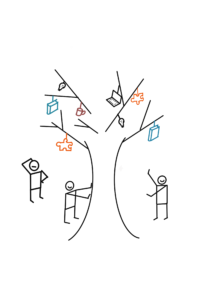We wrote about motivating people to share knowledge a few years ago. We want to revisit that topic in light of the pandemic and expand on how agile methodologies impact knowledge sharing.

First, consider this process a public library: knowledge management (KM) puts the books together and decides how to organize them on the shelves. Knowledge sharing is creating the process of sharing those books with the people who need that information.
Thus, the knowledge sharing process allows your team to establish a central source of referrals for important and relevant information in general or for a specific project. It can be anything from team processes to the workplace code of conduct. If someone in your team wants to look for information, they know exactly where to go.
When your team shares and stores relevant project information in a database or file-sharing system regularly, everyone has access to it. This means the information is not owned by a single person, which is very important if that person gets sick or leaves the company. Knowledge sharing means that the rest of the team has the information needed to keep the workflow running smoothly, no matter what happens.
Next, we can expand on previous knowledge-sharing based on what we learned from the pandemic experience and agile methodologies.
- From the pandemic, we learned about 100% distributed working. We wrote about it here.
- We wrote about pair programming and artifact ownership to facilitate knowledge sharing from here.
Finally, agile methodologies further impact knowledge sharing, including team spaces, collaborative sessions, e.g., daily standup, iteration planning, review, and retrospectives. Here are some recommendations that will help to foster knowledge sharing in your company:
1. Develop a Strategy for Knowledge Sharing
If your organization is in the early stages of knowledge sharing, you can start by developing a communication and knowledge management strategy. The best way is to collaborate with other teams and decide what information is relevant or important to be documented and in which context. For example:
- Hold a retrospective to decide on methods and strategies for retaining knowledge
- Formalizing the agile ceremonies, participations, expectations
- Defining virtual or physical team spaces for collaboration
2. Promote the Right Culture
Supporting or fostering a culture of sharing starts at the top. If company managers are willing to share how their processes work and lead transparency, individual contributors are likelier to follow suit. It is crucial that company management provides opportunities for knowledge sharing to happen organically, systematically, and naturally. This means showing vulnerability is welcomed and not punished, as everyone should be able to share all kinds of work and project experiences, including the not-so-positive ones. One way of doing this is creating workplace spaces that promote organic knowledge sharing. For example:
- Collaborative team spaces
- Finance joint business+technical agile ceremonies
- Coffee corners
3. Promote the Different Options of Knowledge Exchange
I believe it’s safe to assert that communication is key to knowledge sharing. However, your team members may have different preferences and abilities when it comes to communication. Some may be good at summarizing information in writing, while others prefer to communicate verbally. This means that different team members have different ways of sharing information. However, regardless of how relevant information is shared, it all must be accessible and in one place. For example:
- Knowledge management platforms that support different types of files, including visuals, e.g., Confluence, SharePoint
- Web meetings, e.g., WebEx, MS Teams, Zoom
- Face-to-Face meetings, team events
- Pairing sessions
- Agile ceremonies: daily standup, iteration planning, reviews, retrospectives
4. Identify the Team Experts
All teams have some people who are experts in processes or certain topics, regardless of the size of the company or the project. If your company or project is starting, find the people who create the processes and ask them to write them down. For larger projects, work with team leaders to identify specific people with expertise in certain areas. It is very important to document procedures and information so everyone can refer to them. For example:
- An agile coach to facilitate knowledge of agile practices, games, etc.
- A technical writer to facilitate the comprehension of information
- A user experience (UX) designer to make a product or service more usable and user-friendly
5. Establish a Collaborative Knowledge Base
As previously mentioned, team members may have different preferences for sharing project information, but there should be a central place to collect all this information. A digital knowledge base allows team members to upload and update information as needed easily. With digital knowledge management, teams will be up-to-date since the information can be updated in real-time. If this is done regularly, it prevents team members from accessing outdated or unnecessary information. For example:
- Task boards such as Jira, Azure DevOps,
- File sharing such as Confluence, SharePoint